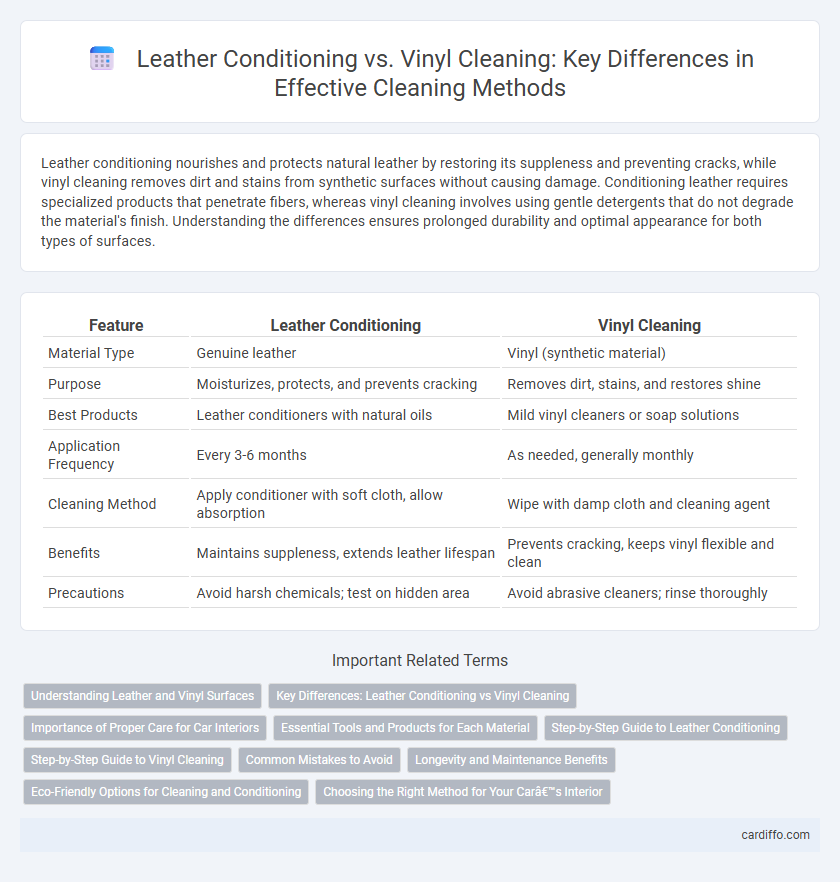Leather conditioning nourishes and protects natural leather by restoring its suppleness and preventing cracks, while vinyl cleaning removes dirt and stains from synthetic surfaces without causing damage. Conditioning leather requires specialized products that penetrate fibers, whereas vinyl cleaning involves using gentle detergents that do not degrade the material's finish. Understanding the differences ensures prolonged durability and optimal appearance for both types of surfaces.
Table of Comparison
| Feature | Leather Conditioning | Vinyl Cleaning |
|---|---|---|
| Material Type | Genuine leather | Vinyl (synthetic material) |
| Purpose | Moisturizes, protects, and prevents cracking | Removes dirt, stains, and restores shine |
| Best Products | Leather conditioners with natural oils | Mild vinyl cleaners or soap solutions |
| Application Frequency | Every 3-6 months | As needed, generally monthly |
| Cleaning Method | Apply conditioner with soft cloth, allow absorption | Wipe with damp cloth and cleaning agent |
| Benefits | Maintains suppleness, extends leather lifespan | Prevents cracking, keeps vinyl flexible and clean |
| Precautions | Avoid harsh chemicals; test on hidden area | Avoid abrasive cleaners; rinse thoroughly |
Understanding Leather and Vinyl Surfaces
Leather surfaces require specialized conditioning products that penetrate pores to maintain flexibility and prevent cracking, while vinyl cleaning involves removing dirt and grime from a non-porous, synthetic material using mild detergents and disinfectants. Understanding the cellular structure of leather helps identify the need for oils and moisturizers, whereas vinyl's plastic composition demands surface cleaning without absorbing agents. Proper care ensures longevity by addressing leather's natural breathability and vinyl's resistance to moisture and stains.
Key Differences: Leather Conditioning vs Vinyl Cleaning
Leather conditioning restores natural oils and suppleness to maintain durability, while vinyl cleaning removes surface dirt and prevents cracking without altering texture. Leather requires specialized conditioners rich in lanolin and oils, whereas vinyl benefits from mild detergents and protectants designed to preserve flexibility. The main difference lies in leather's need for nourishment versus vinyl's focus on cleaning and protection against fading and brittleness.
Importance of Proper Care for Car Interiors
Proper care for car interiors enhances durability and maintains aesthetic appeal, with leather conditioning and vinyl cleaning requiring distinct approaches. Leather conditioning prevents cracking and preserves suppleness by replenishing natural oils, while vinyl cleaning removes dirt and UV damage to avoid fading and brittleness. Using specialized products for each material ensures longevity and protects the vehicle's resale value.
Essential Tools and Products for Each Material
Leather conditioning requires specialized products such as pH-balanced leather cleaners, nourishing conditioners with lanolin or beeswax, and soft microfiber cloths to maintain suppleness and prevent cracking. Vinyl cleaning involves the use of mild detergents, vinyl-specific protectants with UV inhibitors, and soft-bristled brushes to remove dirt without damaging the flexible surface. Both processes benefit from tools like sponges and rinsing sprays, but the selection of conditioning or cleaning agents must match the material's unique composition to ensure durability and appearance.
Step-by-Step Guide to Leather Conditioning
Leather conditioning involves a precise step-by-step process starting with cleaning the surface using a gentle leather cleaner to remove dirt and oils. Following this, apply the conditioner evenly with a soft cloth, allowing it to penetrate and nourish the leather, restoring moisture and flexibility. Finish by buffing the surface lightly to enhance the leather's natural sheen and protect it from future wear, ensuring durability beyond simple vinyl cleaning techniques.
Step-by-Step Guide to Vinyl Cleaning
Vinyl cleaning requires a gentle yet thorough approach starting with removing surface dust using a soft brush or microfiber cloth. Next, apply a specialized vinyl cleaner or a mild soap solution, scrubbing softly in circular motions to lift grime without damaging the surface. Rinse with clean water and dry with a microfiber towel to prevent streaks and maintain vinyl's durability.
Common Mistakes to Avoid
Avoid using harsh solvents or abrasive tools on leather as they can strip natural oils and cause cracking, whereas vinyl requires gentle cleaners to prevent surface damage and discoloration. Overconditioning leather can result in a sticky residue that attracts dirt, while excessive moisture on vinyl can lead to mold growth or peeling. Always use products specifically formulated for each material to maintain durability and appearance effectively.
Longevity and Maintenance Benefits
Leather conditioning enhances durability by preventing cracks and maintaining flexibility, significantly extending the lifespan of leather surfaces. Vinyl cleaning removes dirt and prevents surface degradation, but it lacks the deep nourishment leather conditioning provides. Proper maintenance with leather conditioners reduces repair costs over time, while vinyl requires more frequent cleaning to preserve appearance and function.
Eco-Friendly Options for Cleaning and Conditioning
Eco-friendly leather conditioning often utilizes natural oils like jojoba or coconut, which penetrate the hide without harmful chemicals, preserving flexibility while reducing environmental impact. Vinyl cleaning in sustainable practices employs biodegradable detergents or vinegar-based solutions that effectively remove dirt and grime without releasing toxic residues into waterways. Choosing plant-based products and avoiding synthetic solvents supports healthier indoor air quality and lowers pollution associated with traditional leather and vinyl maintenance.
Choosing the Right Method for Your Car’s Interior
Leather conditioning preserves the natural oils and suppleness of leather car seats by penetrating deep into the material, preventing cracks and wear. Vinyl cleaning focuses on removing dirt and grime from synthetic surfaces without causing damage, often using specialized cleaners that maintain flexibility and shine. Selecting the right method depends on identifying the interior material accurately to ensure longevity and maintain aesthetics in automotive care.
Leather conditioning vs Vinyl cleaning Infographic

 cardiffo.com
cardiffo.com